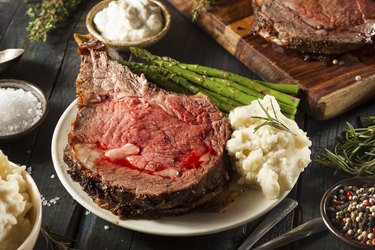
Defining the "best" of anything is a tricky proposition. When it comes to roast beef, for example, the most common cuts are very different. The one that's best for you at any given meal is the one that meets your needs. The roast that's best for a special-occasion meal won't necessarily make the best sandwiches or the tenderest pot roast. Knowing which roast to pick for which purpose is the surest way to always choose the best.
Best for Special Occasions
Video of the Day
When you're looking for a premium roast for special occasions, three cuts stand out. The most visually impressive is the prime rib, with its massive, curving rib bones. It's the most richly marbled of beef roasts, and very tender. The strip loin -- the cut that's used for New York strip steaks -- is its closest rival in flavor and tenderness. It's a relatively flat, oblong cut, so it lacks the imposing visual appeal of a prime rib. For health-conscious diners who want a tender roast with less fat than those other options, the clear choice is a tenderloin. It's the tenderest cut on the steer, but much leaner than rib or strip.
Video of the Day
Best Value for Family Meals
Premium roasts are out of place at ordinary meals, where they'd put a severe dent in your grocery budget. The ideal roast for a sit-down weekend meal is still tender, but rather less costly. Some are cut from the sirloin, a section between the loin and the tougher round. Look for top sirloin and the triangular tri-tip, both of which are excellent. Eye of round is another good option, a compact and lean roast that cooks evenly because of its nearly cylindrical shape. It's not as tender as the sirloin cuts, so it should be sliced more thinly.
Best for Sandwiches
The rich marbling that makes rib roasts or strip roasts so tasty becomes a flaw when you want roast beef for sandwiches. Here, leanness and a dense, even texture is the combination you're looking for. Cuts from the round are perfect for sandwich beef. They have the right texture, and they're large muscles that provide big, even slices to cover your bread or wraps. Pick a big bottom round roast for large slices or eye of round for neat, round slices.
Best for Pot Roast
Paradoxically, all the things that make for a bad oven roast -- tough muscles, gristle and connective tissue -- are advantages in a pot roast. The long, slow cooking required for a good pot roast breaks down the muscle fibers and transforms stringy connective tissue into tasty, gelatin-rich juices. Chuck roasts from the shoulder make especially rich and flavorful post roasts, perfect for a weekend meal. Leaner tough cuts including the brisket and bottom round are less flavorful, but slice more neatly and make a better appearance. They tend not to be as moist as chuck roasts, so be generous with the sauce or gravy.